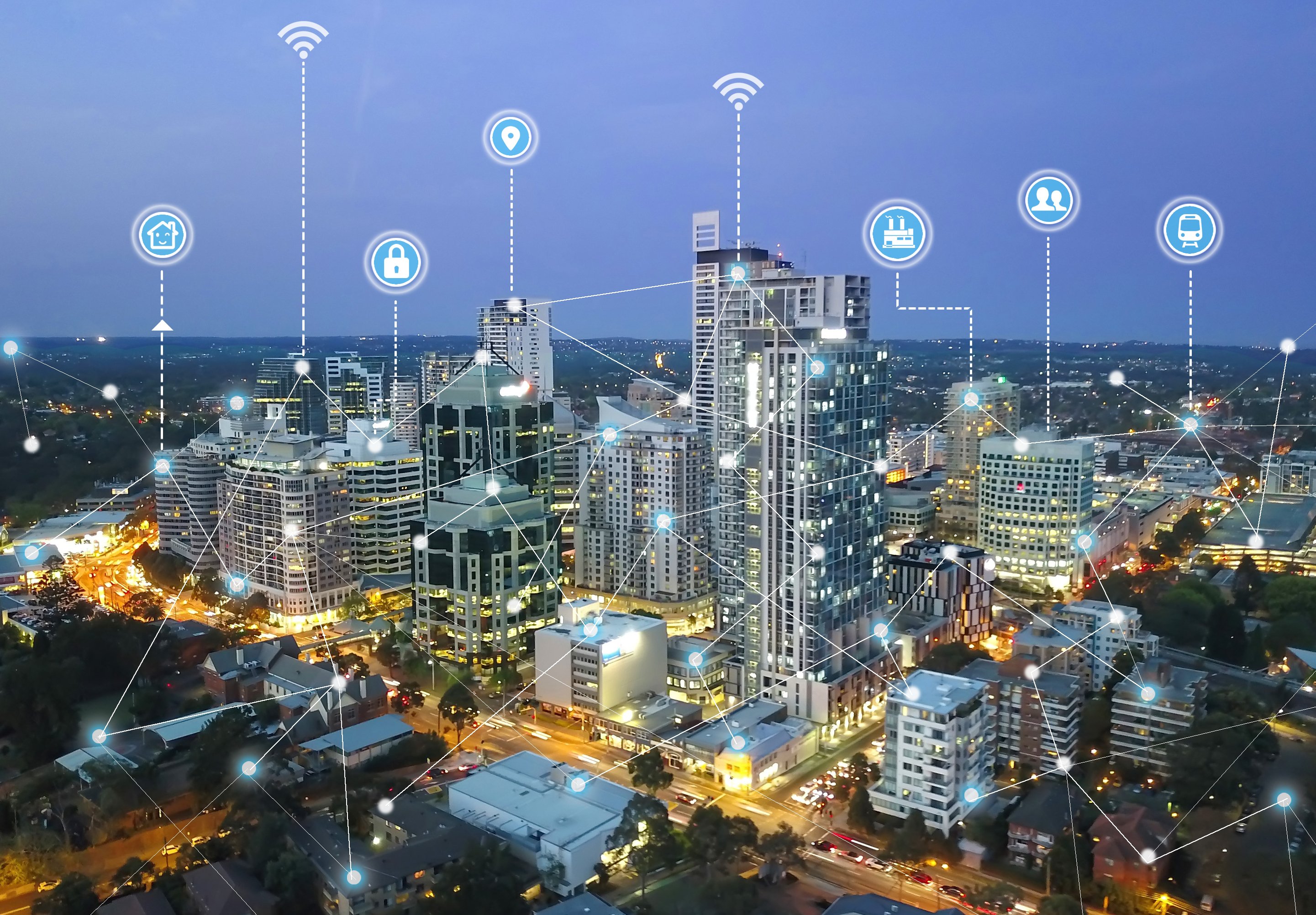
Technology and communication advancements have resulted in organizations increasingly embracing multinational workspaces. Studies show that 83% of organizations that have embraced IoT have reported improved business efficiency.
At the same time, the rise of the Internet of Things (IoT) has ushered in a new era of connectivity and intelligence that has empowered businesses and individuals with real-time insights and control. Innovative businesses have found a way to combine these two, resulting in a game-changing paradigm — IoT-driven smart facility management.
What is Smart Facility Management?
Smart Facility Management (FM) encompasses the integration of advanced technologies to transform traditional facility management practices, enhancing the efficiency, sustainability, and comfort of entire facilities. At the core of smart facilities management is the integration of smart technologies, such as IoT networks, artificial intelligence (AI), and smart devices, which provide real-time data and data-driven insights to support informed decisions by facility managers and building owners.
In essence, smart FM transforms conventional buildings into intelligent environments where systems communicate seamlessly, enabling facility managers to make informed decisions based on comprehensive data insights.
Key Components of Smart Facility Management
-
IoT Integration: At the heart of smart FM is the IoT, a network of connected devices that collect and exchange data. Sensors, actuators, and smart devices work together to monitor and control various building systems, from HVAC and lighting to security and access control. This interconnectedness allows for continuous monitoring and instant feedback, creating a dynamic and responsive facility environment.
-
Data Analytics: The vast amount of data generated by IoT devices is analyzed to uncover patterns, trends, and anomalies. Advanced analytics tools process this data to provide actionable insights, helping facility managers predict potential issues, optimize resource allocation, and improve overall building performance.
-
Automation and Control: Smart FM systems use automation to streamline operations and enhance efficiency. Automated controls can adjust lighting, temperature, and security settings based on real-time data and predefined criteria. This reduces the need for manual intervention and ensures that facilities operate at peak efficiency.
-
Predictive Maintenance: Instead of relying on scheduled maintenance or reacting to equipment failures, predictive maintenance uses IoT data to foresee when maintenance is needed. By analyzing the condition and performance of equipment, facility managers can schedule maintenance proactively, reducing downtime and extending the lifespan of assets.
-
Occupant Experience: Smart FM prioritizes the comfort and productivity of building occupants. IoT devices can monitor environmental conditions, such as temperature and air quality, and adjust them to optimal levels. Additionally, smart systems can provide personalized settings for individual occupants, enhancing their overall experience and satisfaction.
This connectivity and intelligence extend to various aspects of facility management, including energy consumption, maintenance, security, and occupant comfort. Below, we explore practical ways organizations can leverage smart facility management to optimize operations in multinational workspaces.
Current Challenges in Managing Geographically Dispersed Facilities
The evolution towards multinational workspaces presents facility managers with unique challenges due to the geographical dispersion of facilities. Some of these challenges include:
Communication Barriers
As facilities stretch across borders, coordinating maintenance, managing resources, and implementing standardized procedures become intricate tasks. Unfortunately, traditional communication methods often fall short, leading to delays, misunderstandings, and suboptimal decision-making.
This creates a need for real-time, cross-border communication solutions that ensure seamless operations and a consistent user experience for employees.
Diverse Regulatory Compliance
Each country has its own rules and regulations governing facility management. From safety protocols to environmental standards, compliance becomes a multifaceted challenge.
Adhering to these diverse regulations is not only essential for legal reasons but is also crucial for maintaining a sustainable and ethical corporate image. Smart facility management powered by IoT offers a promising avenue for integrating compliance measures efficiently across varied jurisdictions, also known as regtech in the international business community.
Resource Allocation, Optimization, and Operational Efficiencies
The allocation of manpower, equipment, and supplies needs to be optimized to ensure that each location operates at its peak efficiency. Balancing the allocation equation becomes more complex with fluctuating demands, diverse facility sizes, and disparate geographical contexts.
Smart facility management solutions with IoT capabilities can provide data-driven insights for precise resource allocation, enabling a more agile and responsive approach.
Practical Ways to Use Smart Facility Management to Optimize Operations in Multinational Workspaces
With these challenges in mind, here are some practical ways organizations can use IoT to enhance efficiency, streamline processes, and foster a seamless working environment across borders.
Real-time Monitoring and Control
By strategically deploying sensors and devices throughout the multinational workspace, organizations can capture and analyze data in real-time, gaining valuable insights into various aspects of their business.
For example, monitoring energy consumption allows for the immediate identification of inefficiencies, leading to timely corrective actions and significant cost savings. This real-time feedback loop ensures that operational processes are not only efficient but also adaptable to changing conditions.
Real-time monitoring extends beyond energy management. It includes tracking the status of equipment, machinery, and even employee workflows. This level of visibility enables organizations to proactively address issues before they escalate, minimizing downtime and maximizing productivity.
Predictive Maintenance
Traditional maintenance practices often rely on scheduled intervals or reactive responses to equipment failures. However, with IoT-enabled sensors collecting and analyzing data on the condition of machinery, organizations can shift to a proactive maintenance approach.
By predicting when equipment is likely to require maintenance based on performance data, organizations can optimize maintenance schedules, reduce downtime, and extend the lifespan of critical assets.
With IoT-driven predictive maintenance, organizations can avoid these unexpected disruptions, ensuring a more stable and efficient multinational workspace. This approach saves money and contributes to a more sustainable and reliable operational environment.
Asset Tracking and Management
IoT solutions, equipped with GPS and RFID technologies, offer a comprehensive solution to the challenges of monitoring and managing diverse assets across different locations.
Consider a multinational corporation with distributed teams and assets moving between offices or even across borders. IoT-enabled asset tracking ensures that organizations have a centralized and accurate view of their assets, facilitating efficient resource allocation and minimizing the risk of misplacement or theft.
Supply Chain Visibility
IoT technologies offer unparalleled transparency into the complex web of global supply chains. By leveraging sensors and connectivity, multinational corporations can track the movement of goods and raw materials in real-time. This visibility enhances decision-making by providing insights into the status of shipments, potential delays, and even energy consumption. More innovative solutions are already being tested in smaller-scale, residential environments.
What's more, the small size of IoT sensors lends to universal application throughout the production process. In addition, their interconnected nature and model-driven architecture allow for interoperability with other platforms, which results in significant increases in data collection efficiency.
Even a mid-size roofing company with suppliers, manufacturers, and distributors across different countries can benefit from this. By integrating roofing software with IoT sensors in their workshops and warehouses overseas they can get real-time data about inventory, order status, conditions, and much more, ensuring every step of the process is monitored, from production to delivery.
This reduces the risk of disruptions and allows the company to optimize routes, manage inventory more effectively, and ultimately enhance the overall resilience and efficiency of its global supply chains.
Occupancy and Space Optimization
Multinational corporations often struggle to optimize workspace utilization, especially in diverse work environments with varying norms, team sizes, and requirements.
IoT sensors provide a powerful solution by offering real-time insights into occupancy levels and space usage. By strategically placing sensors throughout the workspace, organizations can gather data on how different areas are utilized, identifying patterns and trends.
In a multinational context, where office layouts and cultural work preferences may vary across regions, IoT-driven optimization becomes a valuable tool for creating flexible and adaptive work environments that cater to the diverse needs of global teams.
Security and Access Control
Securing physical and digital assets, not just machinery and networks is a paramount concern for multinational corporations. Recently, to combat cyber threats and improve overall team cohesion, organizations are opting for custom tools—from PDF software development kits for document management to bespoke solutions for communication, sensor control, and more.
Thus, it's imperative to broaden the focus beyond merely the software and firmware aspects of key industrial equipment. The evolving landscape of cyber threats necessitates a vigilant approach toward all third-party elements, recognizing them as potential vectors for cyber attacks.
IoT technology encompasses an array of sophisticated systems, including biometric authentication mechanisms, IoT-enabled smart locks, and advanced video surveillance setups. When these components are synergistically integrated, they form a robust framework for access control, offering enhanced surveillance and proactive threat detection capabilities. This comprehensive approach ensures a fortified security posture, tailored to the unique demands of disparate workplace environments.
Environmental Sustainability
Promoting environmental sustainability is a global imperative, and IoT technologies contribute significantly to this goal within multinational workspaces. Organizations can reduce their environmental footprint and implement the ISO 50001 energy management system framework by monitoring and optimizing energy consumption, waste management, and water usage.
For example, smart storage facilities equipped with IoT sensors can automatically adjust lighting, heating, and cooling based on occupancy and environmental conditions, leading to energy savings.
By embracing IoT for environmental sustainability, multinational corporations align with global environmental goals and demonstrate corporate responsibility and leadership in sustainable business practices.
Data Analytics for Performance Optimization
The sheer volume of data generated by IoT devices provides an opportunity for organizations to harness the power of data analytics for performance optimization.
By analyzing data patterns and trends, multinational corporations can gain valuable insights into operational efficiency, employee productivity, and customer behavior. Far from the production floor, they can then use these insights to drive informed decisions, identify areas for improvement, and predict future trends.
For instance, data from IoT devices in different warehouses can be analyzed using artificial intelligence (AI) to forecast demand for specific products. Research indicates that over 60% of companies already use AI to generate accurate sales forecasts. Combining this with data from IoT devices from facilities in multiple countries can lead to even more accurate plans, timely facility renovations, and much more.
CONCLUSION
The integration of IoT technology into facility management is reshaping multinational workspaces, offering real-time solutions and proactive strategies for optimizing operations.
For organizations considering implementation, the time is now. Embracing IoT unlocks new levels of efficiency, collaboration, and sustainability, positioning your organization at the forefront of innovation in the global business landscape.
It's evident that IoT will feature greatly in the future of workplace technology trends. The question, therefore, is not whether to implement IoT but rather how soon organizations can embark on this transformative journey.














